
What is a “Shoji”
The “Sho” in Shoji holds 3 different meanings. The first is to conceal or block from view, the second, to divide or separate, and the last meaning is to cordon off. The Shoji originally was installed on the inner side of a wall opening or window.
In the olden times, the “Fusuma”aka the sliding door was called the “Shoji“, and the Shoji as we know of today was called the “Akari Shoji“, so as to distinguish between the two.
The Shoji has been a part of Japanese peoples livelihood since the Heian period (794-1185 A.D.) and has decorated and complimented the rich Japanese culture.
Up until now, various materials, functions, and modeling beauty have been incorporated in Shoji design.
As you are aware, it has also greatly improved the modern interior design of today. Shoji is often looked at as an option to add beauty as well as simplicity to any room that it is intended for.
Besides the obvious Japanese-style rooms, Shoji’s can be added to the interior of a Western-style room, hotels, apartments, and even high-rise buildings. The limitations are endless.
The beauty and functionality of the Shoji are again, starting to attract focus and attention on a worldwide scale.
Attributes of a Shoji
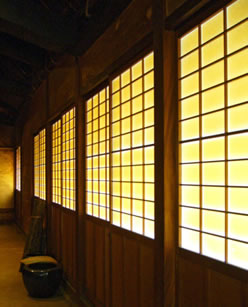
1.Illuminate the room in a soft, even ambient light.
The Shoji’s translucent Japanese paper filters and dissipates direct rays of light, by 40-50%. Appearance-wise, it will keep the ambient gentle daylight, while blocking out the direct rays of the sun. The light that passes through the Shoji is diffused in every direction, and illuminates the whole room evenly. The contrast between the sharpness of light near the window and dark areas in the back corners of the room will be eliminated. The whole room is wrapped in a soft, uniform light, providing homogeneousness lighting.
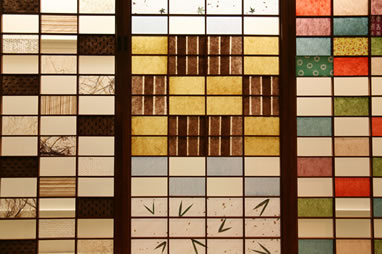
2. Natural appeal, beauty of geometric lines.
The materials of a Shoji are generally wood and paper”… A Shoji can be seamlessly incorporated in present-day interior design, while providing a feeling or presence of nature. The perpendicular lines of the wood frame in conjunction with the white paper textured weave, creates geometric beauty, which brings together an interior space. It also creates a main focal point of any room. Replacing the paper of the Shoji periodically will rejuvenate the look of the room as well as change the image of the room so that it can be enjoyed.
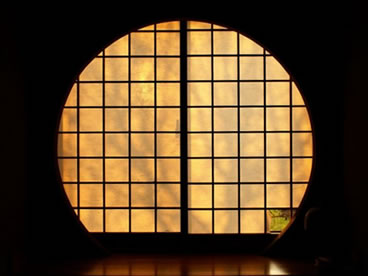
3. Heighten the illumination effect at night.
The surface of the Shoji becomes one with its surrounding walls. The interior light sources reflect off the Shoji paper, resulting in an efficient way of providing warm indoor illumination. The reflection of light off of Shoji paper is 50-60%. The reflected light harmonizes with the color of wood and or hardware, to create beautiful space.
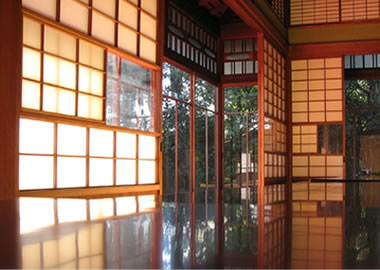
4. Warms in winter and cools in the summer.
A Shoji installed room is an effective energy saving method. Since a Shoji covers and absorbs solar radiated heat, a decrease of inflow heat to about 1/2 when compared with a clear glass window. (transmissivity : about 90%). Since cooling by method of fan or air conditioning is needed to offset the solar heat source, only half the cooling resources is needed, thus, the energy-saving effect can be quite substantial. Overnight, the warmth and heat accumulated in the room during the daytime will dissipate as a cause of radiative cooling. Having a Shoji will act as insulation or barrier from windows and escape routes of heated air. If the interior of the room side is mostly constructed from wooden materials, it will have low thermal conductivity and it is more advantageous in terms of thermal loss than that of a double-glazed window with a metal sash.
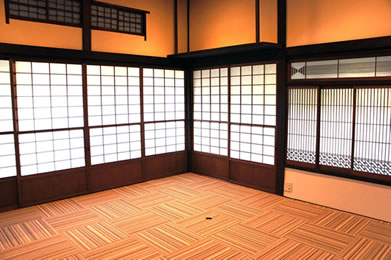
5. Controlling the interior temperature of a room comfortably.
Even In the case of a heated room, the body may get cold when near a window or doorway to the outside. This is called cold draft. The air that is cooled by a wall, window, or doorway falls and it builds a pocket of cold air near the floor underneath the cold draft source. Installation of an inner Shoji will prevent the cold drafts from entering the room. As cold air falls, a glass surface is not exposed directly to the cold air, therefore the cooling of indoor air decreases sharply. As the Shoji paper is porous, it also has ventilation and filtration properties in a natural way which is another special characteristic of Shoji paper. Furthermore, controlling the humidity of the room is also a benefit of Shoji paper, which in turn, keeps the indoor temperature from changing drastically.
A Shoji is suitable for very humid climates such as Japan
